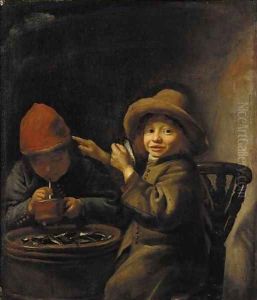Jan Miese Molenaer Paintings
Jan Miense Molenaer was a Dutch Golden Age painter born in Haarlem, Netherlands, in 1610. He was known for his genre scenes, portraits, and historical allegories. Molenaer's work often depicted lively figures and humorous themes, reflecting the everyday life of the Dutch middle class. He was influenced by the Haarlem school of painting, which was characterized by its attention to detail and the depiction of light.
Molenaer married fellow artist Judith Leyster, also a significant figure in Dutch painting, and the two were known to influence each other's work. They had several children, and the family moved to Amsterdam in the 1630s, where Molenaer continued his career. His paintings from this period show a strong influence from the Amsterdam school, with more attention given to the overall composition and the use of warmer colors.
Throughout his career, Molenaer's style evolved. His early works are noted for their detailed characterization and intricate use of light and shadow, reminiscent of his contemporary, Frans Hals. Later, his work showed the influence of other artists such as Adriaen Brouwer and Adriaen van Ostade, with a greater focus on the portrayal of emotion and storytelling.
Jan Miense Molenaer died in Haarlem in 1668. His body of work left a lasting impact on Dutch genre painting, and his paintings can be found in museums and collections around the world, testament to his skill and versatility as an artist.
